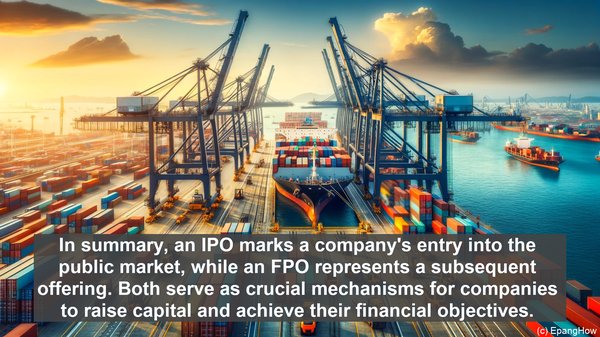Introduction: The Gateway to Public Markets
Hello and welcome! When a company decides to go public, it embarks on a transformative journey. Today, we’ll explore two significant milestones in this journey: the Initial Public Offering (IPO) and the Follow-On Public Offering (FPO). While both involve issuing securities to the public, they differ in several crucial aspects. Let’s dive in!

IPO: The Company’s Debut on the Market
An IPO is often referred to as a company’s ‘initial public offering.’ It’s the first time the company offers its shares to the public. This process is typically undertaken by private companies that want to raise capital, expand operations, or provide an exit opportunity for early investors. The IPO process involves meticulous planning, regulatory compliance, and extensive due diligence. It culminates in the company’s shares being listed on a stock exchange, making them available for public trading.
FPO: A Company’s Subsequent Offering
In contrast, a Follow-On Public Offering (FPO) occurs after a company has already gone public. It’s a secondary offering of securities by a company that’s already listed on a stock exchange. Companies opt for FPOs to raise additional capital, fund expansion plans, or meet other financial objectives. Unlike an IPO, where the company issues new shares, an FPO involves the sale of existing shares held by the company or its major shareholders. These shares are then made available to the public for purchase.

Key Differences: IPO vs. FPO
While both IPOs and FPOs involve issuing securities to the public, there are several distinctions between the two. Firstly, the timing: an IPO is the first public offering by a company, while an FPO occurs after the company is already listed. Secondly, the purpose: an IPO is often driven by the need for capital, expansion, or liquidity, while an FPO is primarily aimed at raising additional funds. Thirdly, the shares offered: in an IPO, the company issues new shares, whereas in an FPO, existing shares are sold. Lastly, the pricing: IPOs often involve an underwriting process, where the price is determined based on market demand and other factors. FPOs, on the other hand, may have a fixed or market-driven price.
Market Impact and Investor Considerations
Both IPOs and FPOs can have a significant impact on the market. An IPO, especially of a well-known company, can generate substantial investor interest and potentially drive up the stock price. FPOs, on the other hand, may lead to increased stock supply, which can temporarily impact the stock’s price. For investors, participating in an IPO or FPO can offer opportunities for capital appreciation, but it’s crucial to carefully evaluate the company’s fundamentals, growth prospects, and the offering’s pricing. Consulting with a financial advisor is often recommended.
